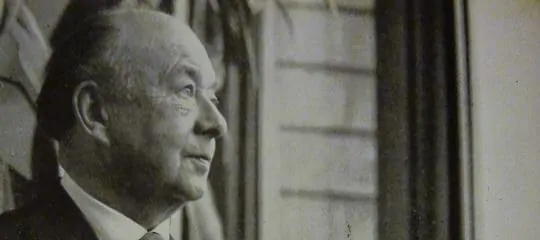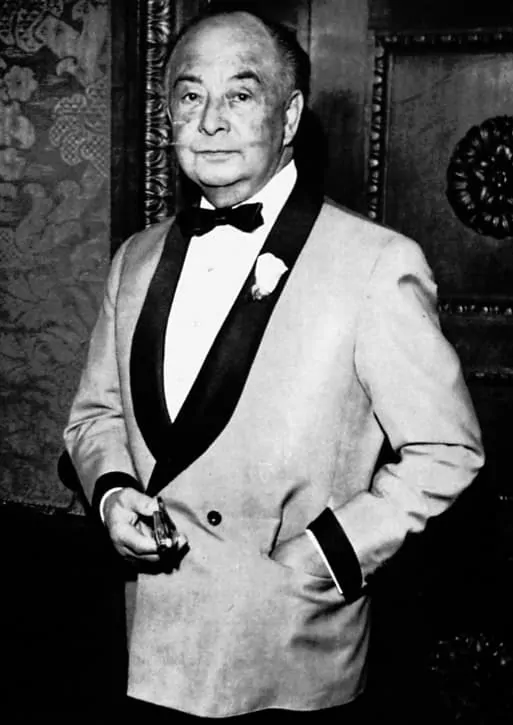
As part of our series on Gentlemen of Style, today, we want to introduce you to Baron von Eelking. Anybody who is interested in 20th century men’s fashion in Germany will stumble upon Baron Hermann-Marten von Eelking. He was the founder of the Deutsches Instituts für Herrenmode (German Men’s Fashion Council), the publisher of the once famous men’s clothing & style magazine Herrenjournal (Gentlemen Journal) and author of a number of books about men’s clothing. In the following, we want to introduce you more closely to Baron von Eelking.

Hermann Marten von Eelking – His Early Years
Born on 1st January 1887 in the city of what is today Poznań, Poland as Hermann Marten Martini August Max into the aristocratic von Eelking family, he visited Klosterschule Ilfeld in 1905. At the time, this school was to Germany what Eton was to England: very prestigious. Even in his early days, von Eelking was interested in dressing well, and so he had more than 30 neckties so he could wear a different one each day of the month.
After he graduated from school in 1909, he followed his father’s wish and enlisted for service academy in order to become an officer. However, he disliked it so thoroughly that he quit after just two years. Subsequently, he matriculated at university where he studied art history in Berlin and Munich. During this time period, he discovered his interest in poetry and published several poems in the style of Börries Freiherr von Münchhausen in several newspapers. In WWI, Eelking was part of a Berlin brigade.
His Career – Junggeselle, Modediktator & Herrenjournal
After he finished his studies, he became aware of the newly created magazine, Der Junggeselle, (The Bachelor) which was published by the Jewish Publisher Nedowitz & Silberstein, and started working for them. Soon thereafter, he was promoted within the company and wrote two articles a week about men’s fashion & etiquette. From 1923 until 1925 he was the editor-in-chief of Der Junggeselle and in 1923, his first book about men’s clothing, Garderobengesetze, (Laws of the Wardrobe) was published. He held leading positions at a number of other magazines. However, in 1927, he once again wanted to write about men’s fashion full time, and consequently started his own men’s fashion magazine called Der Modediktator (The Fashion Dictator). Just three years after its launch it was renamed into the less overblown sounding Herrenjournal (Gentlemen Journal).
Very early on, Eelking realized that different departments of the men’s clothing industry did not harmonize very well together with regard to fashion, and so it was not uncommon to see jackets with wide shoulders and heavy padding combined with a short brimmed hat. Since there were quite a number of such improper items, he decided to found an organization of men’s clothing & accessory manufacturers in order to ensure a coherent look in men’s fashion. It was named Deutsches Instituts für Herrenmode (which is probably best translated with “German Men’s Fashion Council.” Baron von Eelking was the first person worldwide who recognized the problem of colliding wardrobe items and counteracted by creating an organization across company borders. Years later, countries like Italy, France, England as well as the US created similar institutions. The British Men’s Fashion Council is probably the most well known copy of Baron von Eelking’s inital idea.
The Dandy & The War
Apart from his success in men’s fashion, he was a true dandy. His tie collection contained at least 1000 ties. Each time he wore one of these, the seam in the back of the tie was opened, the tie was then ironed and afterwards it was sewn back together! Now that’s dandyesque luxury at its best. He also owned a huge array of walking canes which were used quite regularly.
Baron von Eelking had written each and every article in the Herrenjournal, primarily as on observer and arbiter elegantiarum. However, in 1934 he became a fashion leader by popularizing the combined suit, which consisted of a coat & trousers in different colors and / or patterns. Until then, the only combination that was around during German summer time, was the navy blazer with gray flannel pants and even this ensemble could only be spotted during the summer. Eelking also wore white flannel pants with a brown jacket during the winter.
Between 1932 and 1934, he was pressured by the authorities to share his knowledge about textiles, clothes and clothing history in order to create new uniforms. After he consulted with his Jewish colleagues in the clothing trade, it was decided that he should collaborate and so he wrote the book “Die Uniformen der Braunhemden” (The Uniforms of the Brown Shirts) about military uniforms that he was forced to publish at the Franz Eher Verlag. Also, in 1934, he was reported to the authorities because he had dined with a Jewish colleague. Ever since, he tried to distance himself from the political regime.
In the following years, he began to become extensively interested in wine and so he went on numerous journeys to vineyards, built a huge wine collection in his cellar and started to write a book about wine. Unfortunately, all his notes for the book were destroyed during WWII and the book was never published.
During WWII he did not volunteer to join the military although this was something that was basically expected from him considering that he was once an officer. Furthermore, he moved within the city of Berlin without notifying the authorities of it and, hence, was able to escape the military draft until 1945 (the process of registering your address with the local authorities is to this day a standard procedure in Germany). Meanwhile, the Herrenjournal was stripped of paper and had to cease operations in 1941. The same was true for the Deutsches Institut für Herrenmode. In February 1945, he was forced to join the military but due to a faked medical certificate, he was able to be discharged only two months later in April 1945.
Encyclopedia of Men’s Fashion
During the first years after the war, there was no need for men’s fashion journalists and so he started working on an encyclopedia of men’s fashion – the Lexikon der Herrenmode. The first part of this encyclopedia, which consisted of 482 pages, was finally published in 1960. However, the announced second part was sadly never printed.
As of January 1950, the Herrenjournal was published again, and later that year, the Deutsches Institut für Herrenmode resumed operations.
Baron von Eelking was married four times and had two daughters. He was interested in riding and horses and collected spurs among other things. Generally, he was very meticulous and enjoyed good clothes, food and wine which became evident by his extensive wine, tie, cane and top hat picture collections. Baron von Eelking died at the age of 84 on 19th February 1970 in Berlin.
Books published by Baron von Eelking:
- Das Familienarchiv: Verlag Winter, Darmstadt 1918.
- Garderoben-Gesetze, Budeju-Buchverl., Berlin 1923 reproduced by Finckenstein und Salmuth,2000, Berlin.
- Die Uniformen der Braunhemden, Verlag Eher, München 1934.
- Plaudereien über die Krawatte, Rotsiegel-Krawattenfabrik, 1937, 1955.
- Anzugs -Almanach, Verlag Musterschmidt, Göttingen 1959.
- Lexikon der Herrenmode, Verlag Musterschmidt, Göttingen 1960.
- Das Bildnis des eleganten Mannes, Verlag Herbig, Berlin-Grunewald 1962.
- Gestiefelt und gespornt: Verlag Parey, Berlin 1966.
- Bilanz der Eitelkeit: published 6 years after his death by Musterschmidt, Göttingen, Frankfurt /Main, Zürich 1976
Want To Meet More Gentlemen of Style?
Reader Comments
Comments are closed.